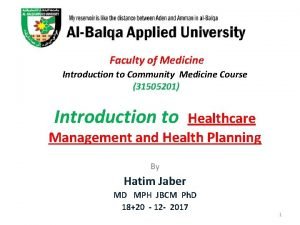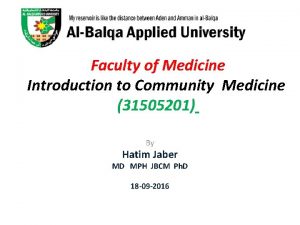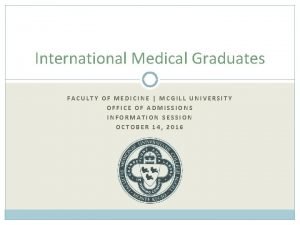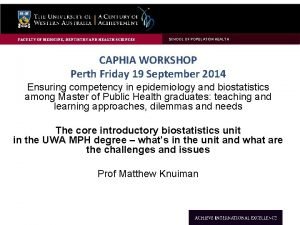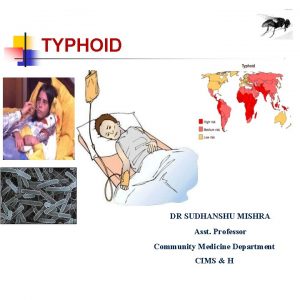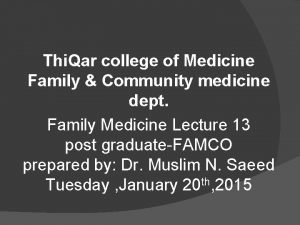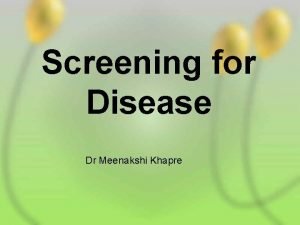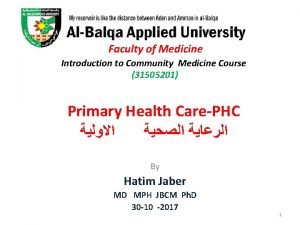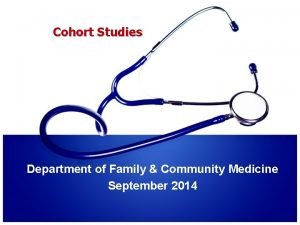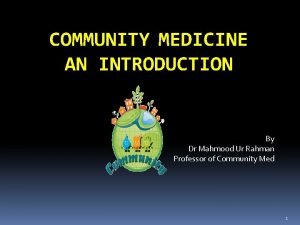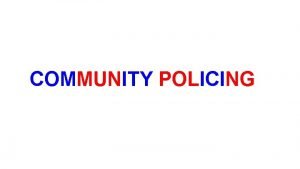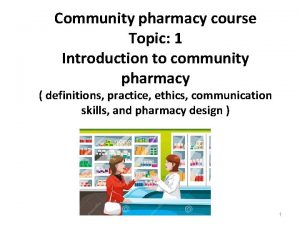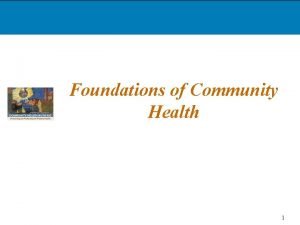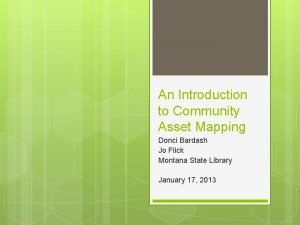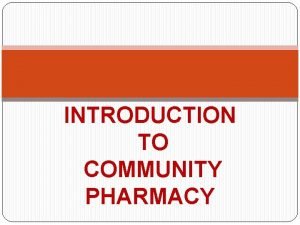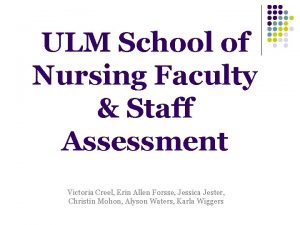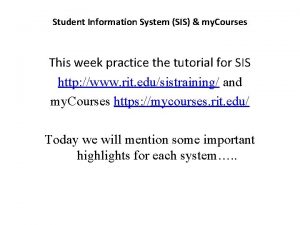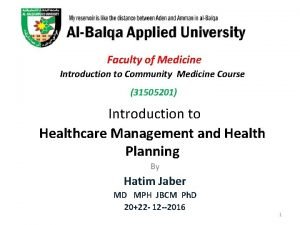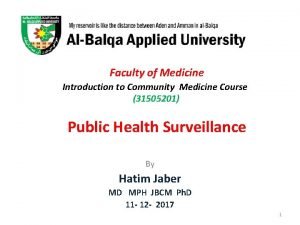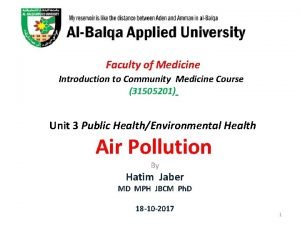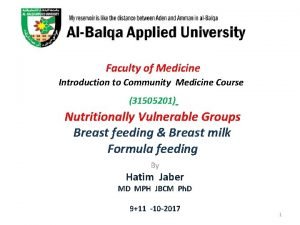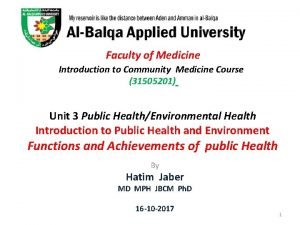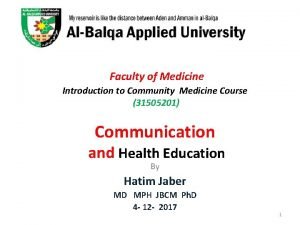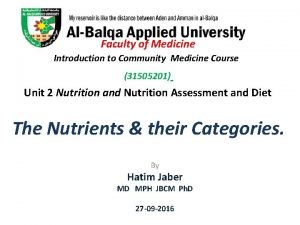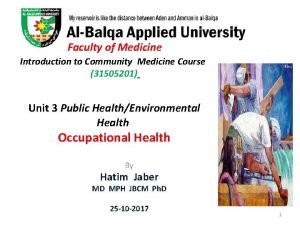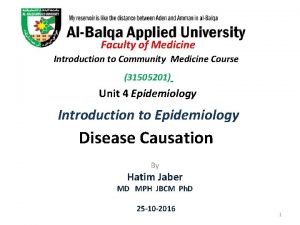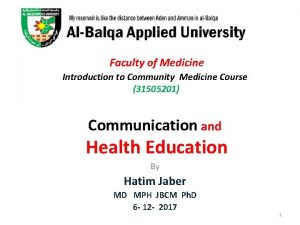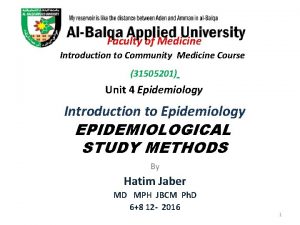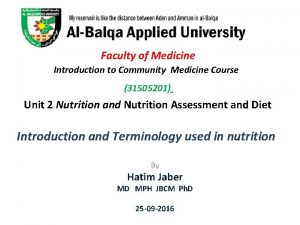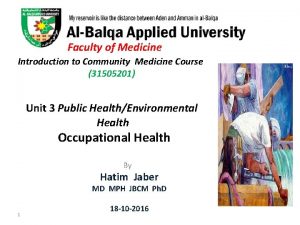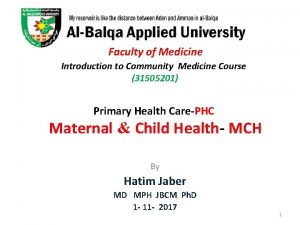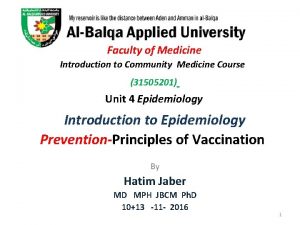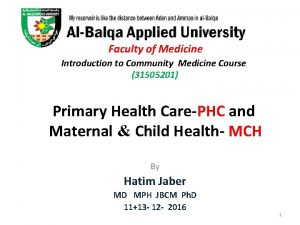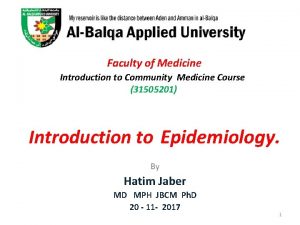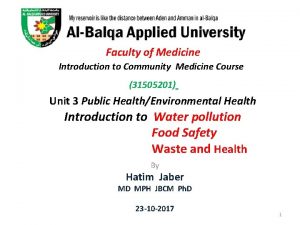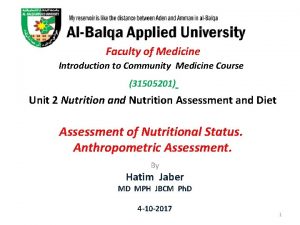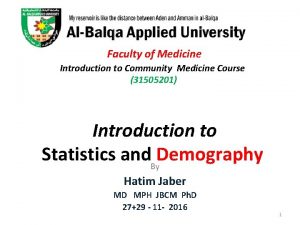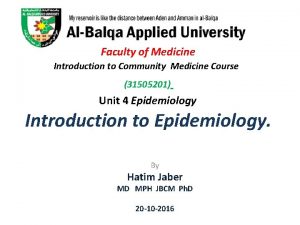Faculty of Medicine Introduction to Community Medicine Course

































































































- Slides: 97

Faculty of Medicine Introduction to Community Medicine Course (31505201) Unit 4 Epidemiology Introduction to Epidemiology Sources of Data and methods of data collection Epidemiological Surveillance By Hatim Jaber MD MPH JBCM Ph. D 20 + 22 - 11 - 2016 1

Introduction to unit 4 Epidemiology • Definition , History of Epidemiology Purpose/Use of Epidemiology • Concepts in the infectious diseases • Disease Causation • Measurements of Morbidity and Mortality • Levels of prevention and vaccination • Screening for diseases and vaccination • Sources of Data and methods of data collection • Epidemiological Surveillance • Epidemic Investigation and Management 2

World Antibiotic Awareness Week • Antibiotics: Handle with care • Date: 14 to 20 November 2016 3

Presentation outline Time Introduction and Definitions 12: 00 to 12: 10 Sources of data 12: 10 to 12: 20 Methods of collecting data 12: 20 to 12: 30 Routine and non routine health data/information 12: 30 to 12: 50 Epidemiological Surveillance Next lecture 4

Objectives • Identify data and the sources for health information • Describe the advantages and disadvantages of each source • Define what is a health information system (HIS) and understand its components • Describe the methods of data collection • Define routine health data/information • Discuss routine data collection methods • Define non-routine data • Discuss methods of collection for non-routine data 5

FROM REALITY TO ACTION Real world (Collection, coding) Data (Processing, interpretation, presentation) Information (Politics, commitment) Action Source: Oxford Handbook of Public Health Practice 6

Definitions and USE OF WORDS ‘DATA’, ‘INFORMATION’ & Knowledge: • DATUM (singular) or DATA (plural) refers to raw numbers or other measures, usually discrete and gives objective facts about events. Data: the raw facts that are collected and form the basis for what we know • INFORMATION refers to what emerges when data are processed, analyzed, interpreted and presented. - Information is data transformed (contextualized, categorized, corrected, calculated, condensed) into a message • Information: the product of transforming the data by adding order, context, and purpose • Knowledge: the product of adding meaning to information by making connections and comparisons and by exploring causes and consequences 7

Definitions cont…. . • “data” means an organized collection of individual measurements for each subject, in respect of every variable of interest. • Once this data has been collected, collated and “summarized” it is called “Information”. • Thus, information is a “factual presentation” i. e. a “Summary of facts” from the data and as they exist without any added element of interpretation of facts. 8

“Why do programs need information? ” • Management level: Community - patient - facility – system • Health-system function: Service delivery - resource mobilization - financing – stewardship • Health determinant: Health care - lifestyle - environment Information is needed to: • (1) understand the program status in all its complexity; • (2) enhance program performance through evidence-based decision making for all major functions (service delivery resource mobilization - financing - stewardship) at all levels (from community to national level)) 9

Definitions • Health system “all resources, organizations and actors that are involved in the regulation, financing, and provision of actions whose primary intent is to protect, promote or improve health. ” (WHO, 2000) • Program procedures A set of to conduct activities. The objective is normally the solution to a problem Neither a health system or program is a static phenomena. They experience a continuous process of changes due to pressure from both outside the system and from within the system. 10

11

Definitions • Health Information System (HIS): A health-information system (HIS), similar to a health management information system (HMIS) “…a system that provides specific information support to the decision-making process at each level of an organization” (Hurtubise, 1984) • Data Systems “a way of talking about the whole set of M&E indicators in a performance monitoring-and-evaluation plan, and all of the data and other information that need to be gathered and understood in an orderly fashion that makes sense and help in program management and implementation” 12

The Health Information System: Routine Data for Planning, Monitoring and Evaluation TYPE National Level District Level Aggregated Service Statistics Aggregated Mgmt Data Aggregated Surveillance Data Financial Data Vital Registration Systems Aggregated Service Statistics Aggregated Mgmt Data Sentinel Sites Observation Checklist Self-Evaluation (e. g. COPE) Non-Routine USE Policy-Making Strategic Planning Program Tracking Disease Surveillance Technical & Logistical Support Planning (Access) Management (Quality/Efficiency) Supervision (Performance) Disease Surveillance Facility/ Client Records Financial Records Supply Records Facility logbooks/data records Aggregated Community Data Client Mgmt and Follow-Up Health Unit Management Work Planning/Priority Setting Community Birth and Death Records School Records CBD logbooks Drug Revolving Fund records Client Mgmt and Follow-up Supplies Management Community Awareness Population-based surveys e. g. DHS Rapid Assessment Methods Facility-based surveys e. g. Situation Analysis, SPA Special Studies e. g. EPI cluster surveys, KAP studies, etc. Census 13

14

HIS subsystems or information systems • Tools or HIS subsystems or information systems: are The various data collection and processing mechanisms that comprise a health information system • Epidemiological surveillance for notifiable infectious diseases, certain environmental conditions, and risk factors; • Routine service reporting from the basic health services at community level, health centers, dispensaries, first-level hospitals, referral hospitals, and special and tertiary hospitals; • Special program reporting systems such as Tuberculosis Control, Leprosy Control, Malaria Control, Maternal and Child Health and Family Planning, Expanded Program on Immunization, and HIV/AIDS prevention; • Administrative systems including health-program budget management, health-financial systems, health-personnel systems, health supply and logistic systems, health-training programmes, health-research management, health-documentation management, and managing external health resources for health; and • Vital registration of births, deaths, and migration. • Demographic: • Population 15

Minimum Information required by a Public Health Specialist in most Settings • General Information : Location, Governmental and Societal patterns, geographical and topographical features, roads & other communications, languages, physical and climatic characteristics of the block / district. • Socio - demographic profile : Population size, age & sex constitution, distribution of population in different areas of the district, fertility indicators, growth rate, education, occupations and economic strata. • Morbidity and Mortality : Incidence or prevalence of mortality, morbidity and diseases with epidemic potential; demographic indices as infant mortality and maternal mortality rates. • Health Related indicators : water supply, disposal of excreta, housing patterns, food availability. • Health Services : Strength and location / distribution of various categories of health care personnel, governmental and non - governmental; availability, location and adequacy of health care supplies, equipment and other logistics. • Preventive / Promotive Health programs : Availability, locations and adequacy of major programs as immunization, HIV - AIDS / TB 16

Types of Information • Surveillance – Epidemiological – Behavioral • • Routine service reporting Special program reporting systems Administrative systems Vital registration systems Facility surveys Household surveys Censuses Research and special studies 17

Frequency of Data Collection • ROUTINE or continuous data collection – Health facility-based (patient information and service statistics) – Community-based (service-statistics) – Program-based (administrative) – Vital registration – Sentinel reporting/demographic surveillance • NON-ROUTINE or periodic data collection – – Household or facility-based surveys Population census Rapid-assessment procedures (RAP) Special studies/research 18

Geographic System Levels • National • Sub-national (e. g. district) • Program area 19

20

21

I. Sources of Data • There are different sources of data on health and health related conditions in the community. Each source has advantages and limitations. The information obtained from these sources is used for health planning, programming and evaluation of health services. The major sources are the following. 22

Data Sources: Population § § Census Vital registration system Sample household surveys Special population surveys - Demographic (elderly, youth) - Risk groups ( IDUs) - Occupational (farmer, skilled labor) - Area-based (catastrophe-affected) § Biomarkers 23

1. Census: • Census is defined as a periodic count or enumeration of a population. • Census data are necessary for accurate description of population’s health status and are principal source of denominator for rates of disease & death. • It provides information on: • Size and composition of a population • The trends anticipated in the future. • • . Age, sex and size of the population Mortality, fertility Language, ethnicity Housing 24

1. Census: cont… • The amount of data collected may vary, from as little as population size and age / sex structure on one end to a large number of: • social, economic, demographic and health related variables on the other end; however, a fairly developed census mechanism would usually provide information regarding: total population, density according to per square kilometers of land area, decadal growth rate, literacy rate, economic conditions, occupational characteristics, and selected indicators of mortality like overall death rate and infant mortality rate. 25

1. Census: cont… • From these data different health indices could be calculated: • Crude birth rate, • crude death rate, • age specific mortality rate and sex specific mortality rate are some of the examples of the indicators that could be calculated Limitation • Conducting nationwide census is very expensive and it generates a large amount of data which takes a very long time to compile and analyze. . • It is carried in intervals of many years (10 years). Therefore it can’t assess yearly changes 26

1. Census: cont… Sample Surveys • In sample surveys, instead of covering the whole population as is done in census, only a sample, which is representative of the population, is studied and inferences about the population strength and composition are made. • Sample surveys are quite relevant in underdeveloped countries where full fledged census is not possible; they are also useful in countries where census mechanism is present because they give interim information without waiting for the census which is generally done after 10 years. 27

In Jordan census was conducted in……………. . 28

29

30

31

2. Vital statistics: • Vital statistics means the ongoing recording of all vital events’ such as births, deaths, marriages etc. Registration of Births and Deaths is a legal requirement in our country • This is a system by which all births and deaths occurring nation wide are registered, reported and compiled centrally. The main characteristics of vital statistics are: • Comprehensive – all births and deaths should be registered. • Compulsory by law – should be enforced by law. • Compiled centrally so that it can serve as a source of information. • Continuous – it should be an ongoing process. 32

2. Vital statistics: cont…. • (a) Death Certificate : It is one of the most important source of information about the distribution of a number of diseases. 33

2. Vital statistics: cont…. • (b) Birth Certificates : These are useful for epidemiologic research as well as health services management; • they provide a denominator data for calculating various important rates IMR, MMR, etc. • Ideally, a birth certificate should contain information about date, place of birth, details of parents, domiciliary/ institutional birth, sex of newborn birth attendant’s details, type of delivery and complications if any, age of mother and birth order of the child. • (c) Other vital events : These include registration of marriages and divorces; reporting of still births; an reporting of fetal deaths. 34

35

36

3. Health Service Records • All health institutions report their activities to the Ministry of Health. • The Ministry compiles, analyzes and publishes it in the health service directory. It is therefore the major source of health information. Advantages: • Easily obtainable • Available at low cost • Continuous system of reporting • Causes of illness and death available. 37

38

3. Health Service Records cont… Limitations: • Lack of completeness – health service coverage is low. • Lack of representativeness – a small proportion of diseased population seeks medical advice. Those patients who remained at home are not reported. • Lack of denominator – catchment area is not known in the majority of cases. • Lack of uniformity in quality. • Diagnosis varies across the level of health institutions. • Lack of compliance with reporting. • Irregularity and incompleteness of published compilations. 39

3. Health Service Records cont… • Notification of Infectious Diseases • There are some internationally notifiable diseases. WHO member • states report on Plague, Cholera, and Yellow fever. • Moreover, every country has its own list of notifiable diseases. • The major problems related to this source (health service records) are low compliance and delays in reporting. 40

4. Health Surveys What is a Survey ? A Survey collects information Is a Census from all the population Is a Poll if for political information Is a Sample Survey if from just a sample of a population 41

4. Health Surveys cont… • Health surveys are studies conducted on a representative sample population to obtain more comprehensive data for monitoring the health status of a population. There are two types of health surveys: • 1. Surveys of specific diseases: These are studies conducted on each specific disease. Examples are: • EPI target diseases • Diarrheal Diseases • HIV/AIDS • Tuberculosis / Leprosy • 2. Surveys of general health status: These are studies on general health status of the population. They are based on interview, physical examination and laboratory tests. They are expensive. 42

4. Health Surveys cont… • Advantages of surveys based on interview: • They are more representative of the health condition of the community. • The denominator is known. • Data are more uniform in quality. • Limitations: • Data accuracy is dependent on the memory and cooperation of the interviewee. • Surveys are expensive. 43

44

Information from Special Populations • Some groups have well maintained and extensive health data (e. g. uniformed services, factories, mines, occupational groups, Insurance policy holders, persons covered by various health insurance programs etc • Records of Hospitals and Health Services • In developing countries with inadequate notifications of morbidity and mortality, hospital records are important tool for the epidemiologist as well as the health administrator. • Even in countries with a well developed system of notification, hospital records are often used for epidemiological assessments and clinical research. In addition to hospitals, records from other health services (national health program offices, Community/Primary Health centers) also provide valuable data. 45

Other Sources of Information Depending on the information needs, the epidemiologist may need data from the: • Epidemiological studies: valuable but expensive • meteorological / environmental departments; • from governmental offices regarding availability of medical/ paramedical manpower and available training facilities; • or data of controlled drugs and their utilization may have to be obtained from the relevant Drug Controller’s office. 46

II. Methods of data collection • The main methods of collecting information are: • 1. Observation • 2. Interview and questionnaires • 3. Documentary sources - Clinical records and other personal records, death certificates, publications etc. 47

48

49

“Surveillance” 50

The word “Surveillance” • The word "sur-veillance" means (in French) "to watch from above" ("veiller" = "to watch" and "sur" = above") (i. e. a God's-eye view looking down from on-high) • The term is often used for all forms of observation, not just visual observation. 51

Definition of Surveillance Public health surveillance (sometimes called epidemiological surveillance) is : the ongoing systematic collection, analysis, and interpretation of outcome-specific data essential to the planning, implementation, and evaluation of public health practice, closely integrated with timely dissemination of these data to those who need to know. Outcomes may include diseases, injury, and disability, as well as risk factors, vector exposures, environmental hazards, or other exposures. The final link of surveillance chain is the application of these data to prevent and control human diseases and injury. 52

Surveillance Principle Surveillance is: “Information for Action” “If you don't use it, then do not ask for it!” However: “Good surveillance does not necessarily ensure the making of the right decisions, but it reduces the chances of the wrong ones” A. D. Langmuir (1963) 53

History • In 1950, the term “surveillance” was restricted to public health practice to watching contacts of serious communicable diseases” – To early detect symptoms – To institute prompt treatment – Example: Smallpox 54

Surveillance, surveys, registries and HMIS: • Surveillance is systematic ongoing collection, collation, and analysis of data, and the timely dissemination of information to those who need to know so that action can be taken • A survey is a one data collection episode • Registries are not for immediate action • Health Management Information Systems (HMIS) for annual reports 55

Note the Differences: • Registers are archival health information • Surveillance is dynamic as compared with surveys: Interplay between epidemiologic studies and control activities • Surveillance is not mere: – Reporting – Monitoring – Data collection 56

Continuous versus Periodic Data Collection Continuous Data Collection Periodic Collection Data Collection Small team Large team or multiple teams Data accessibility Initially slow Faster turnaround Data usefulness for trend analysis Ongoing results Results only after three rounds of data collection Evaluation of health intervention Continuous monitoring of Timing of collection often not impact linked to intervention Budget Line item in health budget One-off investment at each cycle 57

Goals and Uses of Surveillance • Detect outbreaks or epidemics – – Detect changes in trends over time, portray natural history of diseases Evaluate control measures – Making projections, understanding burden of disease and justifying allocation and or redirection of resources • Estimate magnitude of morbidity and mortality – Ensure equity in health care (mortality and morbidity) • Facilitate planning • Stimulate epidemiologic research – – 58 Generate/ Test hypotheses (e. g. changes in health practice) Identify risk factors (in-depth studies)

Uses of Public Health Surveillance • • • Estimate magnitude of the problem Portray the natural history of a disease Determine distribution and spread of illness Detect outbreaks Generate hypotheses, stimulate research Evaluate control and prevention measures Monitor changes in infectious agents Detect changes in health practices Facilitate planning 59

Objectives of Surveillance • Early detection and prediction of outbreaks • Description of the magnitude of disease • Understanding risk factors for diseases • Monitoring trends of endemic disease • Monitor programme performance and progress towards a control objective • Estimate future disease impact 60

Added values of Surveillance • High-quality surveillance increases credibility of public health care providers: – – – 61 Encourages transparency Reduces over-reaction Attract donors Encourages implementation of new interventions; new conjugate meningococcal vaccines Facilitates better management of disease control and other public health programs SAVES LIVES !!!!

Importance of Good Reporting Health Care System Reporting Intervention 62 Data Analysis & Interpretation Evaluation Event Public Health Authority Feedback Information

Delayed Detection Means Delayed Response First Case Late Detection CASES Delayed Response Opportunity for control DAY 63

Early Detection… • Early warning indicators: – Count of cases (? ) – Attack rates (stratified) – Case-fatality rates • Temporal component • Defined thresholds • Notification of cases – Suspect and probable – Case-based data – Immediate or weekly 64

Types of Surveillance • Surveillance may be based on many different data sources • can be classified in a number of ways, • including: i) the means by which data are collected (active versus passive surveillance ); 65

Active vs. Passive Surveillance • Active Surveillance: Health department solicits reports • Passive Surveillance: Reports are initiated by source for data 66

Surveillance of Disease vs. Persons • Surveillance of Disease: “ The continuing scrutiny of all aspects of occurrence and spread of disease that are pertinent to its effective control” • Surveillance of Persons: “ The continuing scrutiny of disease contacts, high risk groups in order to promote prompt recognition of infection or illness” 67

Levels of Surveillance • National: – Periphery: (e. g. , PHCC catchment area, city) – Intermediate: Provincial – Central • International: – International Health Regulations 2005 68

Special Surveillance Programs • Natural and man-made disasters (emergencies) • During Special events of mass gatherings – – (Pilgrims to Makkah ﺍﻟﺤﺞ Olympics – – Emerging pathogens Antimicrobial resistance • Laboratory-based surveillance: • Infection control • Behavioural risk factors • Others 69

Systems of Disease Surveillance • Notifiable disease reporting systems • Laboratory-based surveillance • Hospital-based surveillance • Population-based surveillance • Vital records (birth and death certificates) • Registries 70

Routine and sentinel surveillance • Sentinel surveillance; The surveillance of a specified health event in only sample of the population at risk using a sample of possible reporting sites. The sample should be representative of the total population at risk. • Passive surveillance; Routine surveillance where reports are awaited and no attempt make actively seek reports from the participants in the system. 71

Sentinel Surveillance • Often provides an early alert for outbreaks – Most useful for diseases that occur frequently – Not intended to capture all cases • Focal points: Clinics, hospitals or laboratories – Strategic locations – Representative to population (socio-demographic) – High risk groups • Less sites but better quality of data bring attention to problems in practices, procedures or systems • Useful for research activities 72

Reporting Channels 73

Reportable Diseases • Vary from one country to another – Differences within countries – Changes over time • Adding one single disease to the list could cost • • a lot: Money, time, avoidable confusion Variables collected should be indicators of potential or arising problems rather than identifying risk factors Report only confirmed cases? 74

Frequency of Reporting Diseases • Weekly? Appropriate most times • Monthly? Less sensitive • Quarterly? At national level • Daily? – Daily reporting could be cumbersome – Daily reporting may be required during emergencies, disasters • Avoid inconsistencies in case definitions • Reporting suspected vs. confirmed cases 75

Data Collection Forms • Should be (for line-listing): – Simple – Minimum content – Layout easy to understand – Easy to reproduce • Special data collection forms: –Special surveillance programs (e. g. , Malaria, vector control) – During outbreaks (Locally acquired or imported? ) – Eradication activities 76

Public Health Laboratories • Fully linked to epidemiological surveillance • Ability to confirm diagnosis of epidemic – prone • diseases of national interest Monitor and report selected pathogens – Meningococcal meningitis and other bacterial meningitis – Cholera, Shigellosis and salmonellosis – Viral Hemorrhagic fevers, etc • Monitor antimicrobial resistance 77

Analysis of Surveillance Data 78

Key Indicators • Absolute numbers • Proportions • Rates • Percentages • Threshold 79

Information Management 80

Evaluation of Surveillance Systems 81

Goals of Evaluation of Surveillance • To improve existing surveillance systems • To modify systems because of changes in – Priorities – Epidemiology – Diagnostics • To optimize the use of available resources 82

International Health Regulations 2005 • Current: Notification to WHO of a case of cholera, plague or yellow fever. . . . • IHR 2005 – – – 83 Public health emergencies of international importance Obligation to establish core capacities Assistance to States Context specific & flexible recommended measures External advice (emergency and review committees) regarding IHR

Information Loop of Public Health Surveillance Public Reports Summaries, Interpretations, Recommendations Health Care Providers Health Agencies Analysis 84

National Notifiable Disease Surveillance • Reporting mandated by state law/regulation • Health care providers, laboratories report to local HD (county) • County HD submits reports to State • Reports transmitted to CDC primarily through National Electronic Telecommunications System for Surveillance (NETSS) 85

86

DEFINITIONS • Disease notification is a process of reporting the occurrence of disease or other healthrelated conditions to appropriate and designated authorities. • A notifiable disease is any disease that is required by law to be reported to government authorities. 87

DEFINITIONS • A notifiable disease is one for which regular, frequent, and timely information regarding individual cases is considered necessary for the prevention and control of the disease. • Physicians are required by law to report cases of certain infectious diseases. Unfortunately, many do not. 88

REASONS FOR SURVEILLANCE • Evaluate the effectiveness of control and preventative health measures • Monitor changes in infectious agents e. g. trends in development of antimicrobial resistance • Support health planning and the allocation of appropriate resources within the healthcare system. • Identify high risk populations or areas to target interventions • Provide a valuable archive of disease activity for future reference. 89

Notification: when and how • IDSR form 001: For immediate/case based reporting of diseases. • Immediate reporting allows for timely action to be taken to prevent the re-emergence or rapid transmission of epidemic prone diseases or events, especially diseases due to highly pathogenic and lethal infectious. 90

Notification: when and how • Make the initial report by the fastest means possible (telephone, text message, facsimile, email, radiophone). . . • Follow up the initial verbal report with a written report of the case-based report form. • IDSR 001 A when the case is suspected and IDSR 001 B when there is laboratory confirmation. • Below is a list of diseases/events requiring immediate reporting. 91

Diseases/Events reported with form IDSR 001 • Acute Flaccid Paralysis (AFP) • Acute hemorrhagic fever syndrome (Ebola, Marburg, Lassa Fever, RVF, Crimean-Congo) • Adverse event following immunization (AEFI) • Anthrax • Chikungunya • Cholera • Cluster of SARI • Diarrhoea with blood (Shigella) • Dracunculiasis • Influenza due to new subtype • Maternal death • Measles • Meningococcal meningitis • Neonatal tetanus • Plague • Rabies (confirmed cases) SARS Smallpox Typhoid fever Yellow fever Any public health event of international concern (infectious, zoonotic, food borne, chemical, radio nuclear or due to an unknown condition) • • • 92

Notification: when and how • IDSR form 002: For weekly reporting of new cases of epidemic/pandemic prone diseases. • IDSR form 003: For routine monthly notification of other diseases of public health importance. 93

Diseases that require monthly reporting • • • Acute viral hepatitis • AIDS (New Cases) • • Buruli ulcer Diabetes mellitus • Diarrhoea with severe dehydration in children under 5 • years of age • HIV (new detections) • Hypertension • Influenza-like illness Injuries (Road Traffic Accidents) Leprosy (quarterly) Lymphatic Filariasis Malaria Malnutrition in children under 5 years Mental health (Epilepsy) Noma Onchocerciasis Severe pneumonia in children under 5 years of age • Sexually transmitted diseases (STIs) • Trachoma • Trypanosomiasis • Tuberculosis (quarterly) • Underweight Newborns (less than 2500 g) 94

CHAIN OF REPORTING HCP WHO/CDC DNO LG MOH FMOH SMOH Key: HCP: Health care providers DNO: Disease notification officer LG MOH: Local Government Medical Officer of Health SMOH: State Ministry of Health FMOH: Federal Ministry of Health 95

Surveillance Team Needs to Work Together 96

97
 Introduction to community medicine
Introduction to community medicine Introduction to community medicine
Introduction to community medicine Hubert kairuki memorial university faculty of medicine
Hubert kairuki memorial university faculty of medicine Semmelweis university faculty of medicine
Semmelweis university faculty of medicine Mrbs scholarship
Mrbs scholarship Applied medical sciences
Applied medical sciences Agnes csaki semmelweis
Agnes csaki semmelweis Faculty of veterinary medicine cairo university logo
Faculty of veterinary medicine cairo university logo Hacettepe university faculty of medicine
Hacettepe university faculty of medicine Conus arteriosus
Conus arteriosus Semmelweis university faculty of medicine
Semmelweis university faculty of medicine Mcgill medicine supporting documents
Mcgill medicine supporting documents Faculty of veterinary medicine cairo university
Faculty of veterinary medicine cairo university Pubh4401
Pubh4401 Emory anticoagulation clinic
Emory anticoagulation clinic Cairo university faculty of veterinary medicine
Cairo university faculty of veterinary medicine Faculty introduction speech
Faculty introduction speech One brick t junction in english bond
One brick t junction in english bond Course number and title
Course number and title Course interne course externe
Course interne course externe Drinking water
Drinking water Lt lead time
Lt lead time Types of family in community medicine
Types of family in community medicine Lead time in community medicine
Lead time in community medicine Kashif rahim
Kashif rahim Types of family in community medicine
Types of family in community medicine Cohort study community medicine
Cohort study community medicine Duke medicine grand rounds
Duke medicine grand rounds Seqs community medicine
Seqs community medicine Prepare to scale up in community mobilization
Prepare to scale up in community mobilization Introduction to banking course
Introduction to banking course Imbe introduction course v2
Imbe introduction course v2 Introduction to software engineering course outline
Introduction to software engineering course outline Ron had a course introduction
Ron had a course introduction Cleft sentences examples
Cleft sentences examples Ron had a course introduction
Ron had a course introduction Introduction to forensic medicine
Introduction to forensic medicine Introduction of community policing
Introduction of community policing The apprentice pharmacist
The apprentice pharmacist Characteristics of community health nursing
Characteristics of community health nursing An introduction to community asset mapping
An introduction to community asset mapping An introduction to community asset mapping
An introduction to community asset mapping Introduction to community pharmacy
Introduction to community pharmacy Herszon kherson maritime college of merchant marine fleet
Herszon kherson maritime college of merchant marine fleet University of bridgeport computer science faculty
University of bridgeport computer science faculty University of bridgeport computer engineering
University of bridgeport computer engineering Alamo colleges salary schedule
Alamo colleges salary schedule Hahnville high school powerschool
Hahnville high school powerschool Importance of faculty in higher education
Importance of faculty in higher education Http://www-bcf.usc.edu/~gareth/isl/advertising.csv
Http://www-bcf.usc.edu/~gareth/isl/advertising.csv Penn state neurosurgery faculty
Penn state neurosurgery faculty Mercy faculty forward
Mercy faculty forward Lee kong chian faculty of engineering and science
Lee kong chian faculty of engineering and science Faculty kutztown carelli
Faculty kutztown carelli Florida state university computer science faculty
Florida state university computer science faculty Faculty of business and economics mendel university in brno
Faculty of business and economics mendel university in brno Umd ee
Umd ee Factors influencing faculty staff relationship
Factors influencing faculty staff relationship Nit calicut chemistry
Nit calicut chemistry Faculty of civil engineering ctu prague
Faculty of civil engineering ctu prague Ecu faculty manual
Ecu faculty manual Benha faculty of engineering
Benha faculty of engineering Singularity executive program
Singularity executive program Faculty of law maastricht
Faculty of law maastricht Medical faculty in novi sad dean
Medical faculty in novi sad dean Umn faculty dental clinic
Umn faculty dental clinic Sjsu faculty affairs
Sjsu faculty affairs Unlv faculty senate
Unlv faculty senate Ulm nursing faculty
Ulm nursing faculty Ucl computer science meng
Ucl computer science meng Symbiosis project report
Symbiosis project report Training and development metrics
Training and development metrics Https://faculty.washington.edu/chudler/stm0.html
Https://faculty.washington.edu/chudler/stm0.html Parson kutztown
Parson kutztown Student faculty ratio for nba
Student faculty ratio for nba Kfupm clinic
Kfupm clinic Ascaris lumbricoides ova
Ascaris lumbricoides ova Faculty model of training
Faculty model of training Dr veerasamy
Dr veerasamy Fulbright faculty development program
Fulbright faculty development program Faculty of engineering university of porto
Faculty of engineering university of porto Faculty of organizational sciences
Faculty of organizational sciences Charles university faculty of humanities
Charles university faculty of humanities Electrotechnical faculty belgrade
Electrotechnical faculty belgrade Faculty of economics and business debrecen
Faculty of economics and business debrecen Mse iitd
Mse iitd Kfupm ee faculty
Kfupm ee faculty Faculty model of training
Faculty model of training Questrom mba curriculum
Questrom mba curriculum Faculty model of training
Faculty model of training Usf electrical engineering faculty
Usf electrical engineering faculty Faculty of law maastricht
Faculty of law maastricht Faculty of law of the university of zagreb
Faculty of law of the university of zagreb University of montenegro faculty of law
University of montenegro faculty of law Civil engineering faculty
Civil engineering faculty University of kragujevac faculty of technical sciences
University of kragujevac faculty of technical sciences University of cologne faculty of management
University of cologne faculty of management Rit faculty sis
Rit faculty sis
